He16 Bon dance

Hanapepe, Kauai, 1985
Photographed by Kazuhisa Tahara
Bon dancing was first performed in Hawaii at the end of the 19th century on sugar plantations and later at Buddhist temples as a way for Japanese immigrants to remember their hometowns.
When Japanese-related activities were prohibited during WWII, Bon dance traditions ceased. After the war, however, the tradition was revived as a way to commemorate the spirits of the war dead.
From June to early September, Bon dances are held every weekend at more than 80 locations across Hawaii, primarily at Buddhist temples. Before the Bon season begins, a schedule of events is published in newspapers and on the internet. Just as it is performed in Japan, a “yagura” (tower) is set up at the center of the dance grounds, with paper lanterns hanging on strings from its roof, and an expanding layer of dancers encircling it. Large locations can attract several thousands of people. Even many people who do not have Japanese roots come to enjoy the festivities and join in the dances.